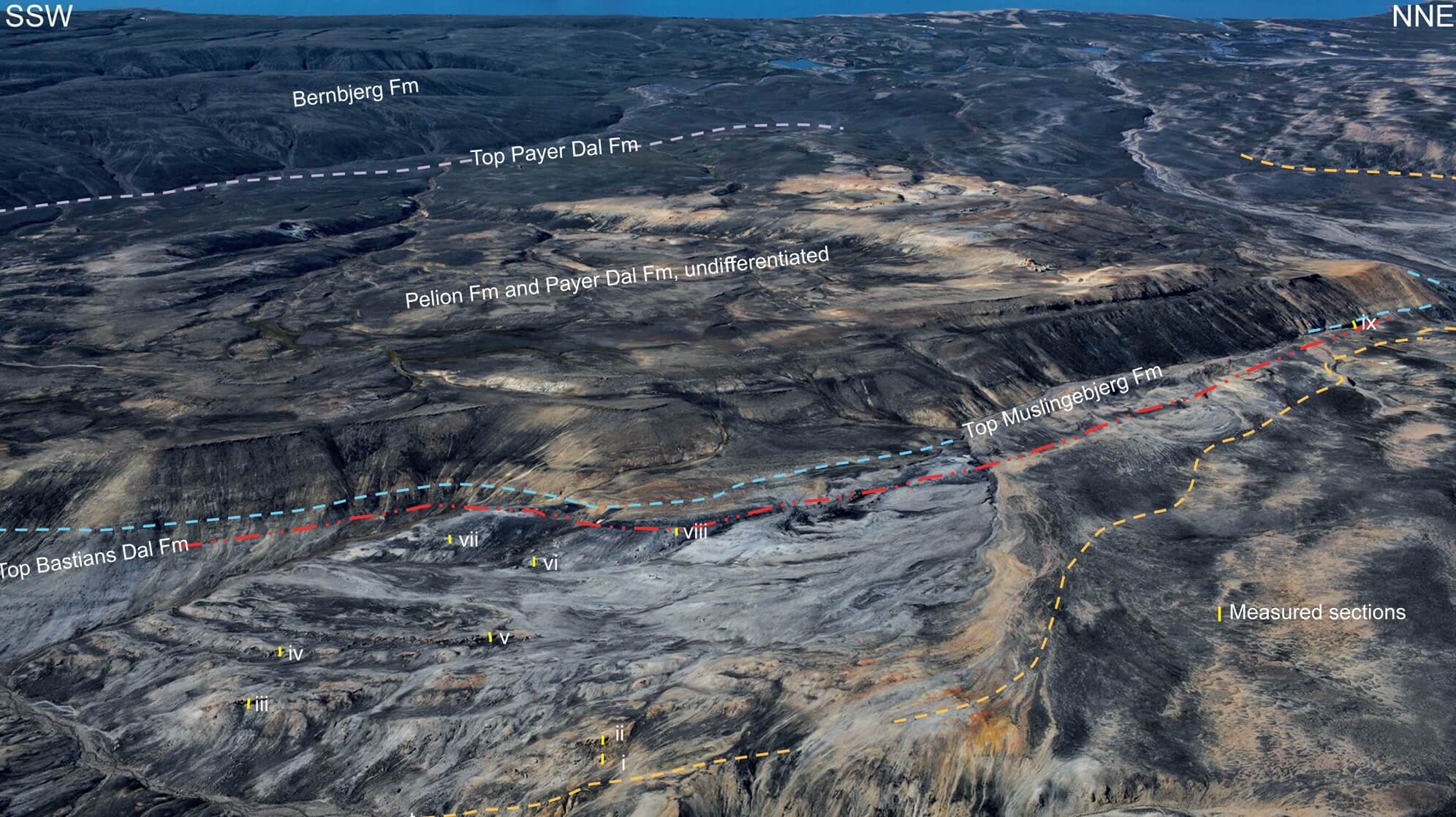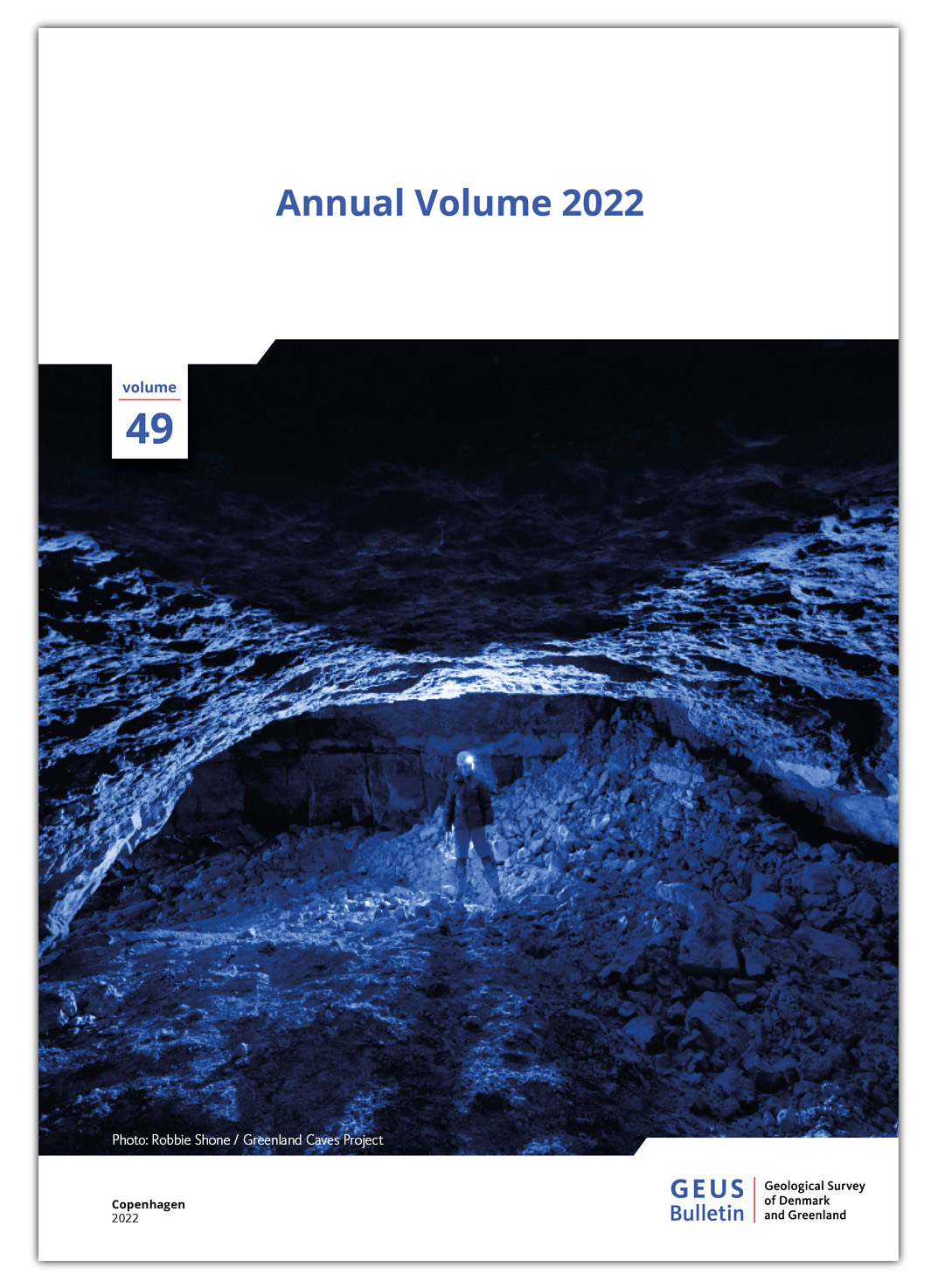
How to Cite
Share
Abstract
The aim of this study is to elucidate the character of the earliest phases of Jurassic rifting in North-East Greenland. To achieve this, detailed sedimentological analysis and geological mapping were undertaken on the outcrops of central Kuhn Ø (74°53’55’’N,20°20’56”W). In this region the basement is overlain by the fluvial Bastians Dal Formation (Middle Jurassic) which is, in turn, overlain by the coal-bearing Muslingebjerg Formation. A maximum thickness of 140 m is calculated for the Bastians Dal Formation and mapping of stratal geometries demonstrates thinning to both the north and south, confirming that these deposits infill a palaeovalley. Predominantly south-westward palaeocurrent orientations are observed and likely reflect the orientation of the palaeovalley (NE–SW). The overlying Muslingebjerg Formation displays significant lateral variations in thickness as well as facies, thickening from a 5-m-thick coal seam in the north to 50 m in the south. Southern outcrops include two intervals of fine-grained sandstones displaying low-angle and trough cross-bedding some of which contain suggestions of tidal bundling. The arrangement of facies suggests that coal formation occurred in both fluvial- and shallow-marine (tidal?) environments. Coals are similar to those described elsewhere from the Muslingebjerg Formation and display subtle differences consistent with variable degrees of marine influence. Mapping demonstrates the presence of an NE–SW-oriented bounding fault in the south of the region into which the Muslingebjerg Formation thickens. This likely also controlled the orientation of the underlying NE–SW-aligned palaeovalley and is oblique to the proposed overall N–S orientation of faulting related to rifting through the Mid to Late Jurassic. Instead, these alignments resemble those that define pre-Jurassic phases of rifting and may therefore indicate a transitional phase of tectonism. Faulting on a similar alignment can be traced SW, cutting Lindeman Fjord and following the valleys east of the A. P. Olsen Land plateau.
How to Cite
Share
Copyright (c) 2022 Steven Andrews, Henrik Vosgerau, Jørgen Bojesen-Koefoed

This work is licensed under a Creative Commons Attribution 4.0 International License.
Funding
This project was jointly funded by GEUS and MIERL.Downloads
An annual collection of articles submitted to GEUS Bulletin, published throughout 2022.
Cover photo: Gina Moseley explores a cave in North-East Greenland. Credit: Robbie Shone / Greenland Caves Project. Read more in Smith, P. & Moseley, G. 2022: The karst and palaeokarst of North and North-East Greenland – physical records of [...]
References
- Ahokas, J.M., Nystuen, J.P. & Martinius, A.W. 2014: Depositional dynamics and sequence development in a tidally influenced marginal marine basin: Early Jurassic Neill Klinter Group, Jameson Land Basin, East Greenland. In: Stevens, T. (ed): From depositional systems to sedimentary successions on the Norwegian Continental Margin. International Association of Sedimentologists Special Publications 46, 291–338. https://doi.org/10.1002/9781118920435.ch12
- Alsgaard, P.C. et al. 2003: The Jurassic of Kuhn Ø, North-East Greenland. In: Ineson, J.R. & Surlyk, F. (eds): The Jurassic of Denmark and Greenland. Geological Survey of Denmark and Greenland Bulletin 1, 865–892. https://doi.org/10.34194/geusb.v1.4691
- Andrews, S.D., Morton, A.C. & Decou, A. 2021: Mid to Late Triassic evolution of the Jameson land Basin, East Greenland. Geological Magazine 158(5), 930–949. https://doi.org/10.1017/S001675682000093X
- Bojesen-Koefoed, J.A. et al. 2020: A mid-Cretaceous petroleum source-rock in the North Atlantic region? Implications of the Nanok-1 fully cored borehole, Hold with Hope, northeast Greenland Marine and Petroleum Geology 117, 104414. https://doi.org/10.1016/j.marpetgeo.2020.104414
- Bojesen-Koefoed, J.A. et al. 1996: Resinite-rich coals of northeast Greenland – A hitherto unrecognized, highly oil-prone Jurassic source rock. Bulletin of Canadian Petroleum Geology 44(3), 458–473. https://doi.org/10.35767/gscpgbull.44.3.458
- Bojesen-Koefoed, J.A. et al. 2012: A remote coal deposit revisited: Middle Jurassic coals at Kulhøj, western Germania Land, Northeast Greenland. International Journal of Coal Geology 98, 50–61. https://doi.org/10.1016/j.coal.2012.04.006
- Bordenave, M.L. et al. 1993: Chapter II-2: Screening techniques for source rock evaluation. In: Bordenave, M.L. (ed.): Applied petroleum geochemistry. pp. 219–278. Paris: Éditions Technip.
- Clemmensen, L.B. & Surlyk, F. 1976: Upper Jurassic coal-bearing shoreline deposits, Hochstetter Forland, East Greenland. Sedimentary Geology 15, 193–211. https://doi.org/10.1016/0037-0738(76)90016-6
- Dahl, B. et al., 2004: A new approach to interpreting Rock-Eval S2 and TOC data for kerogen quality assessment. Organic Geochemistry 35, 1461–1477. https://doi.org/10.1016/j.orggeochem.2004.07.003
- Espitalié, J., Deroo, G. & Marquis, F., 1985: La pyrolyse Rock-Eval et ses applications. Première partie. Revue de l’institut Français du Pétrole 40, 563–579. (In French)
- Guarnieri, P., Brethes, A. & Rasmussen, T.M. 2017: Geometry and kinematics of the Triassic rift basin in Jameson Land (East Greenland). Tectonics 36(4), 602–614. https://doi.org/10.1002/2016TC004419
- Hartley, A.J. et al. 2015: Recognition and importance of amalgamated sandy meander belts in the continental rock record. Geology 43(8), 679–682. https://doi.org/10.1130/G36743.1
- Higgins, A.K. 2010: Exploration history and place names of northern East Greenland. GEUS Bulletin 21, 1–368. https://doi.org/10.34194/geusb.v21.4735
- Holz, M., Kalkreuth, W. & Banerjee, I. 2002: Sequence stratigraphy of paralic coal-bearing strata: an overview. International Journal of Coal Geology 48(3–4), 147–179. https://doi.org/10.1016/S0166-5162(01)00056-8
- Horn, G. 1931: Über Kohlen-Gerölle in Norwegen. Norsk Geologisk Tidsskrift 12, 341–364. (In German)
- Ketzer, J.M. et al. 2003: Sequence stratigraphic distribution of diagenetic alterations in coal-bearing, paralic sandstones: Evidence from the Rio Bonito Formation (early Permian), southern Brazil. Sedimentology 50(5), 855–877. https://doi.org/10.1046/j.1365-3091.2003.00586.x
- Khorasani, G.K. & Murchison, D.G. 1988: Order of generation of petroleum hydrocarbons from liptinitic macerals with increasing thermal maturity. Fuel 67, 1160–1162. https://doi.org/10.1016/0016-2361(88)90388-2
- Koch, L. & Haller, J. 1971: Geological map of East Greenland 72°–76° N. lat.(1: 250,000). Meddelelser om Grønland 183, 26 pp. (13 maps)
- Maync, W. 1947: Stratigraphie der Jurabildungen Ostgrönlands zwischen Hochstetterbugten (75°N) und dem Kejser Franz Joseph Fjord (73°N). Meddelelser om Grønland 132(2), 223 pp. (In German)
- Maync, W. 1949: The Cretaceous beds between Kuhn Island and Cape Franklin (Gauss Peninsula), northern East Greenland. Meddelelser om Grønland 133(3), 291 pp.
- Miall, A.D. 1996. The geology of fluvial deposits: sedimentary facies, basin analysis, and petroleum geology. 582 pp. Springer. https://doi.org/10.1007/978-3-662-03237-4
- Petersen, H.I., Bojesen-Koefoed, J.A. & Nytoft, H.P. 2002. Source rock evaluation of Middle Jurassic coals, northeast Greenland, by artificial maturation: aspects of petroleum generation from coal. American Association of Petroleum Geologists Bulletin 86, 233–256. https://doi.org/10.1306/61EEDA9E-173E-11D7-8645000102C1865D
- Petersen, H.I. et al. 1998: Relative sea-level changes recorded by paralic liptinite-enriched coal facies cycles, Middle Jurassic Muslingebjerg Formation, Hochstetter Forland, Northeast Greenland. International Journal of Coal Geology 36, 1–30. https://doi.org/10.1016/S0166-5162(97)00032-3
- Petersen, H.I. et al. 2013: Unusual resinite-rich coals found in northeastern Greenland and along the Norwegian coast: Petrographic and geochemical composition. International Journal of Coal Geology 109–110, 58–76. https://doi.org/10.1016/j.coal.2013.02.001
- Petersen, H.I. & Vosgerau, H. 1999: Composition and organic maturity of Middle Jurassic coals, North-East Greenland: evidence for liptinite-induced suppression of huminite reflectance. International Journal of Coal Geology 41, 257–274. https://doi.org/10.1016/S0166-5162(99)00022-1
- Piasecki, S. & Stemmerik, L. 2004: Jurassic dinoflagellate cysts from Hochstetter Forland, North-East Greenland. In: Stemmerik, L. & Stouge, S. (eds): The Jurassic of North-East Greenland. Geological Survey of Denmark and Greenland Bulletin 5, 89–97. https://doi.org/10.34194/geusb.v5.4809
- Snowdon, L.R. 1991: Oil from Type-III organic matter: resinite revisited. Organic Geochemistry 17, 741–747. https://doi.org/10.1016/0146-6380(91)90018-F
- Snowdon, L.R. & Powell, T.G. 1982: Immature oil and condensate – modification of hydrocarbon generation model for terrestrial organic matter. American Association of Petroleum Geologists Bulletin 66, 775–788. https://doi.org/10.1306/03B5A313-16D1-11D7-8645000102C1865D
- Surlyk, F. 1977: Stratigraphy, tectonics and palaeogeography of the Jurassic sediments of the areas north of Kong Oscars Fjord, East Greenland. Bulletin Grønlands Geologiske Undersøgelse, 123, 56 pp. https://doi.org/10.34194/bullggu.v123.6665
- Surlyk, F. 1978: Submarine fan sedimentation along fault scarps on tilted fault blocks (Jurassic–Cretaceous boundary, East Greenland). Bulletin Grønlands Geologiske Undersøgelse 128, 108 pp. https://doi.org/10.34194/bullggu.v128.6670
- Surlyk, F. 1990: Timing, style and sedimentary evolution of Late Palaeozoic – Mesozoic extensional basins of East Greenland. In: Hardman, R.F.P. & Brooks, J. (eds): Tectonic events responsible for Britain’s oil and gas reserves. Geological Society Special Publication (London) 55, 107–125. https://doi.org/10.1144/GSL.SP.1990.055.01.05
- Surlyk, F. 1991: Sequence stratigraphy of the Jurassic – lowermost Cretaceous of East Greenland. American Association of Petroleum Geologists Bulletin 75, 1468–1488. https://doi.org/10.1306/0C9B296B-1710-11D7-8645000102C1865D
- Surlyk, F., 2003: The Jurassic of East Greenland: a sedimentary record of thermal subsidence, onset and culmination of rifting. Geological Survey of Denmark and Greenland Bulletin 1, 723–659. https://doi.org/10.34194/geusb.v1.4688
- Surlyk, F. et al. 2021. Jurassic stratigraphy of East Greenland. GEUS Bulletin 46, 6521. https://doi.org/10.34194/geusb.v46.6521
- Surlyk, F. & Clemmensen, L.B. 1983: Rift propagation and eustacy as controlling factors during Jurassic inshore and shelf sedimentation in northern East Greenland. Sedimentary Geology 34, 119–143. https://doi.org/10.1016/0037-0738(83)90083-0
- Surlyk, F. & Ineson, J.R., 2003. The Jurassic of Denmark and Greenland: Key elements in the reconstruction of the North Atlantic Jurassic rift system. Geological Survey of Denmark and Greenland Bulletin 1, 9–20. https://doi.org/10.34194/geusb.v1.4644
- Surlyk, F. & Korstgård, J. 2013: Crestal unconformities on an exposed Jurassic tilted fault block, Wollaston Forland, East Greenland as an analogue for buried hydrocarbon traps. Marine and Petroleum Geology 44, 82–95. https://doi.org/10.1016/j.marpetgeo.2013.03.009
- Sørensen, E.V. & Dueholm, M. 2018: Analytical procedures for 3D mapping at the Photogeological Laboratory of the Geological Survey of Denmark and Greenland. Geological Survey of Denmark and Greenland Bulletin 41, 99–104. https://doi.org/10.34194/geusb.v41.4353
- Swan, A., Hartley, A.J., Owen, A. & Howell, J. 2018: Reconstruction of a sandy point-bar deposit: implications for fluvial facies analysis. In: Ghinassi, M., Columbera, L., Mountney, N.P., Reesink, A.J.H. & Bateman, M. (eds): Fluvial Meanders and Their Sedimentary Products in the Rock Record, 445–474. https://doi.org/10.1002/9781119424437.ch17
- Taylor, G.H. et al. 1998: Organic Petrology. 704 pp. Berlin, Stuttgart: Gebrüder Borntraeger.
- Vischer, A. 1943: Die postdevonische Tektonik von Ostgrönland zwischen 74° und 75°N. Br., Kuhn Ø, Wollaston Forland, Clavering Ø und angrenzende Gebiete. Meddelelser om Grønland 133(1), 195 pp. (In German)
- Vosgerau, H. et al. 2000: Forest fires, climate, and sea-level changes in a coastal plain – shallow marine succession (Early–Middle Oxfordian Jakobsstigen Formation, North-East Greenland). Journal of Sedimentary Research 70, 408–418. https://doi.org/10.1306/2DC40919-0E47-11D7-8643000102C1865D









